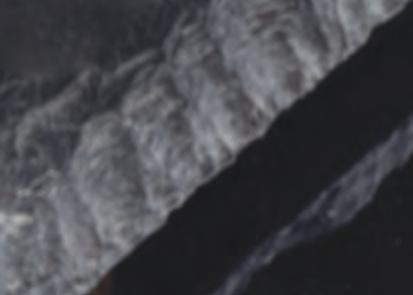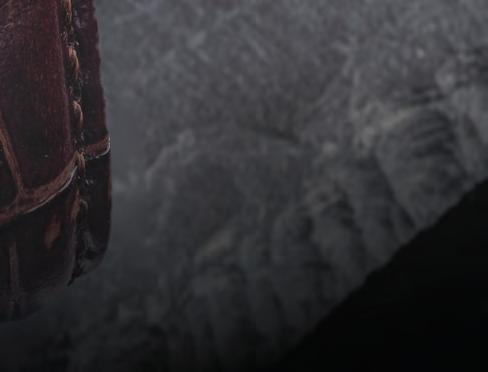
























Ever see a commercial harbor full of Furuno Marine Electronics and wonder why the pros rely on us?





See why here









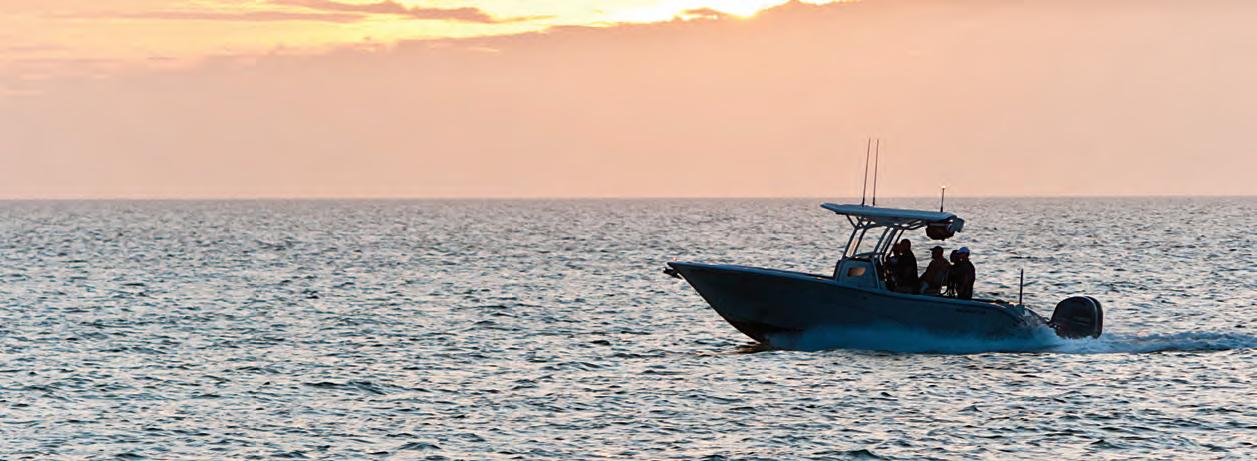
Are you ready to embark on your next on-water adventure? Before you set sail, here are fve things to know about boat insurance.
1. Boat insurance isn’t just for accidents
With comprehensive coverage, you’ll also be protected fnancially for theft, vandalism, and unexpected events like storms if you need repairs or replacements due to damage.
2. Accidents can happen to anyone
When accidents happen, boat insurance offers liability coverage for damages or injuries you cause while boating, up to specifed limits. It can also cover lawsuit costs if you’re sued.
3. Boat insurance can cover medical payments
Boat insurance offers a range of optional medical payments coverage limits, helping to cover medical expenses if you’re in an accident or someone is hurt on your boat, regardless of fault.
4. Most lenders require boat insurance
If you fnanced your boat, you’ll likely need boat insurance since most lenders require boat insurance to protect their investment. Additionally, some marinas or municipalities require proof of insurance for docking.
5. Progressive offers specialized boat coverages
Ever worry about getting stuck on the water?
Progressive’s Sign & Glide® On-Water Towing coverage** can help. It’s an additional coverage that steps in if your boat is disabled or breaks down on the water, paying for on-water towing, jump starts, soft ungroundings, and fuel delivery. Fuel cost isn’t included.
Don’t let unforeseen circumstances disrupt your voyage. Cruise with confdence thanks to Progressive Boat insurance. Because when it comes to your boat, peace of mind is the ultimate luxury.
Scan to get a quote in as little as 4 minutes.
to learn more.




















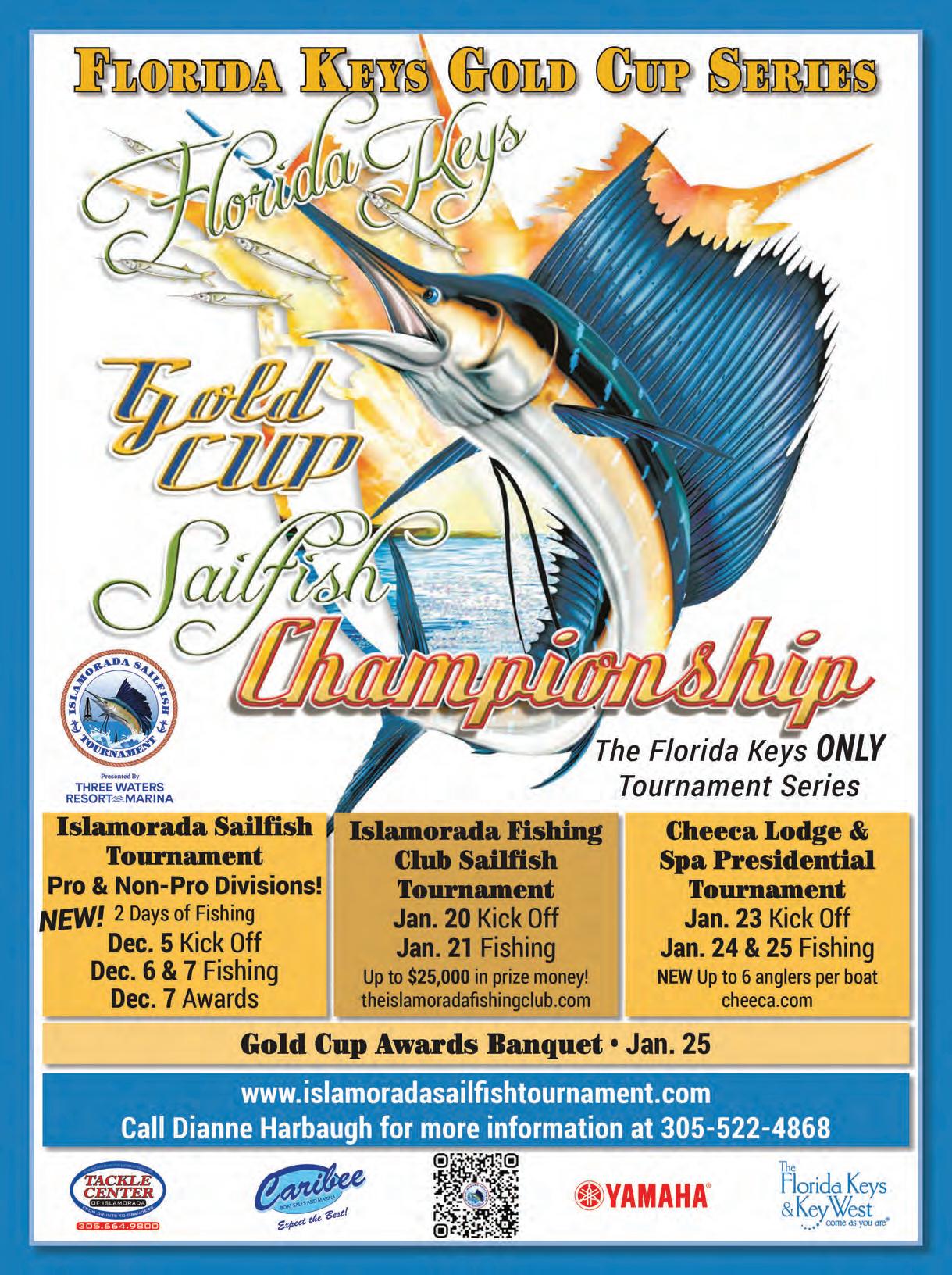


There’s remote, and then there’s Pulley Ridge. Sitting over 100 miles o! the coast of Florida, this underwater plateau is where the Gulf of Mexico drops into the deep blue, and it’s earned a legendary reputation as one of the most productive, and challenging, shing destinations in the U.S.


By Astrid deGruchy
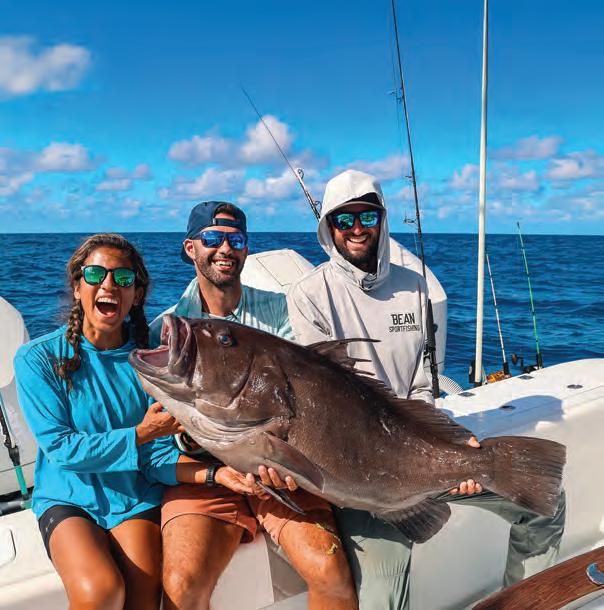

If you’re heading out there, you’ll need a serious o!shore machine. ink a 47’ Freeman or a Viking, something that can handle the long run and unpredictable Gulf conditions. is isn’t a trip for small center consoles or light tackle. Last time we were out there, we loaded up with PENN Fathom electrics paired with PENN Ally Electric rods & PENN International 50 VISX ready to drop into depths that test both your gear and your patience.
Using chicken rigs, we hauled in vermillion and yellow snappers in over 500 . of water that lled the box, but Pulley Ridge has a wild side where giant groupers and the occasional “what-the-heck-is-that” monsters lurk in the dark.


Pulley Ridge isn’t just another shing trip, it’s a rite of passage. e distance, the depth, the unknown, it all adds up to one of those bucket-list adventures every angler should do once in their life, especially with a crew of buddies who live for the chase. While you’re out there, you can even make a stop at the Dry Tortugas, another incredible o!shore destination rich in history and beauty.
Check out the full Pulley Ridge expedition on YouTube, only on Bean Sport shing TV.







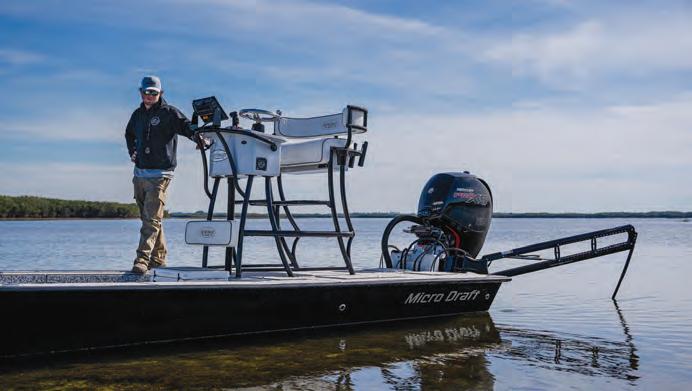





By Julie Graham

The Cherokee National Forest o!ers some of the best freestone trout shing in the Southeast. Spanning 650,000 acres across the Southern Appalachians, it’s the largest block of public land in Tennessee and it’s divided neatly in two by the Great Smoky Mountains National Park.
On the north side, mountain streams tumble through hemlock hollows toward Cosby. To the south, the waters of Citico Creek cut deep through wilderness ridges near the Unicoi Mountains. Together, they showcase the Cherokee’s range. From roadside creeks to backcountry runs, the forest o!ers anglers a taste of freestone Tennessee trout water.
Below the Great Smoky Mountains National Park boundary, Cosby Creek winds through the community of Cosby, Tennessee, o!ering accessible trout
water without the added park permit. ese lower stretches are regularly stocked by the Tennessee Wildlife Resources Agency (TWRA) and can provide productive shing throughout spring and fall. While access is somewhat limited, anglers will nd several bridges and pull-o!s along Highway 32 where they can wade in. e streambed is rocky and slick, with plenty of boulder pockets and undercut banks—good traction and careful footing are essential. Expect stocked rainbows with the occasional brown trout.
Inside the Park, the Cosby Campground section is ideal for bank shing and light wading, especially for those who prefer easy access close to trails and picnic areas. Brook trout dominate the upper reaches, while rainbows hold in the deeper pools below.
To the south, Citico Creek drains more than 20,000 acres of rugged country on the western edge of the Cherokee. Fed by the north and south forks rising in the Unicoi Mountains, Citico o!ers a blend of stocked and wild trout water—ideal for anglers who like a mix of easy access and adventure.
e TWRA regularly stocks Citico from Little Citico Creek to the Citico Creek Wilderness boundary, while the upper forks hold self-sustaining populations of wild rainbows and browns.
e Cherohala Skyway marks the southern edge of the Citico Creek watershed, and just driving it is worth the trip—sweeping vistas, ery fall colors, and the sound of water around every bend.
Autumn is prime time on both sides of the Cherokee National Forest. Water temperatures drop, trout feed hard before winter, and the hardwood ridges turn to ame.
• Match the Hatch: Early fall favors terrestrials; in November, go small with blue-winged olives, midges, and caddis emergers.
• Go Light: Clear, low ows call for 6X or 7X tippet and longer casts.
• Mind the Leaves: Dri leaves can snag a line—look for deeper pools below ri&es where trout hold under cover.
• Start Late: Cooler nights mean shing o en improves mid-morning as the water warms slightly.
For more information, including licensing regulations, visit the Tennessee Wildlife Resources Agency at https://www.tn.gov/twra.html.


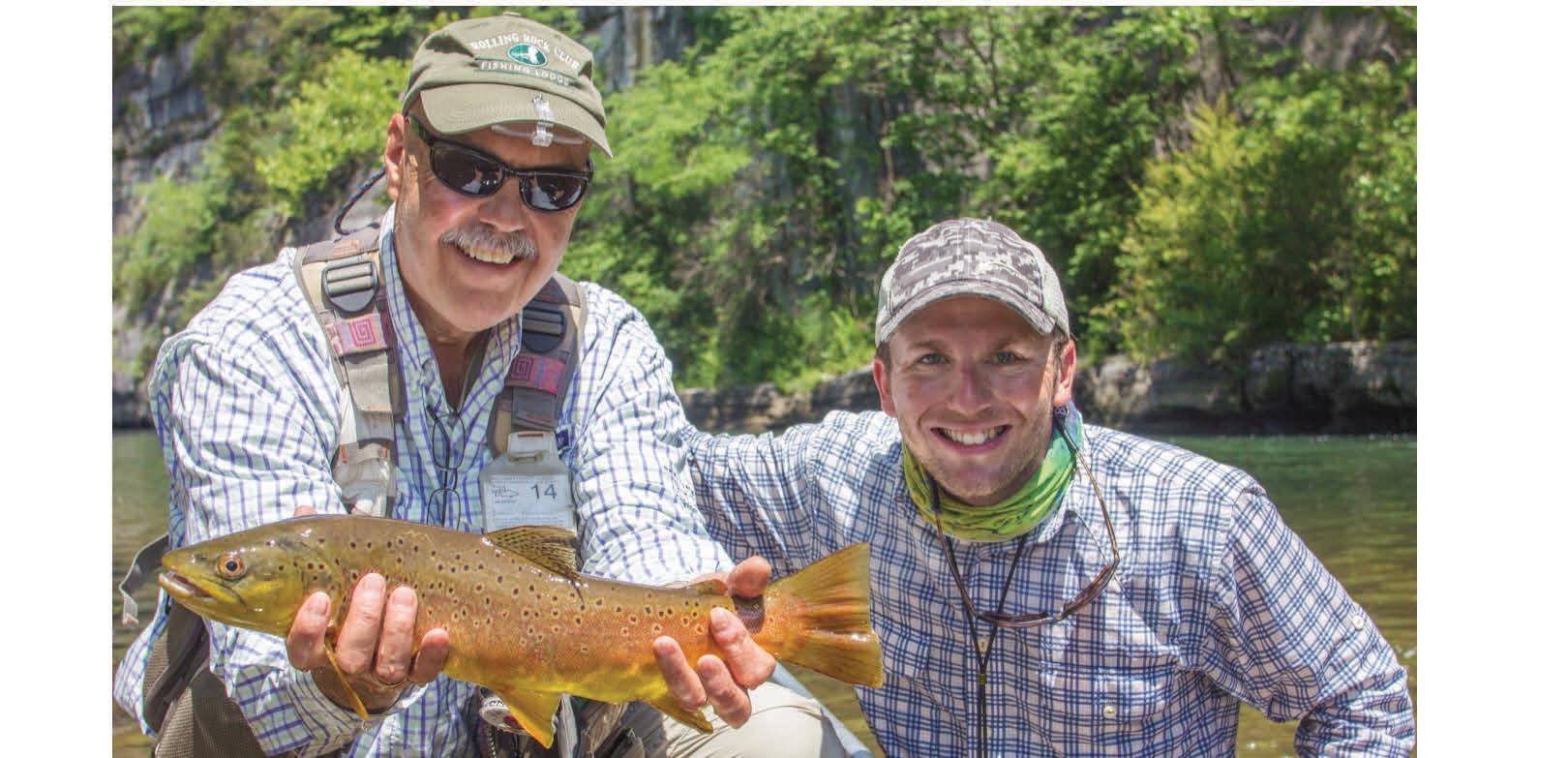








































































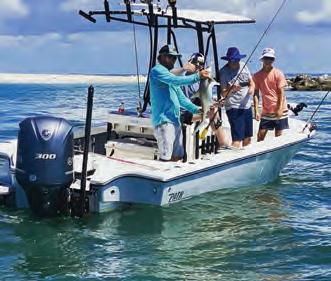






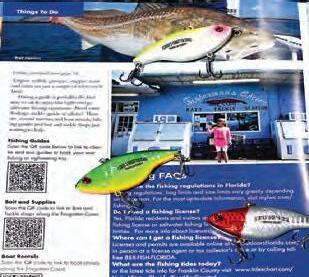













www.coastalanglermag.com/lowcountry

by Chris Pounder, Contributing Writer
ovember is one of my favorite months to fish as the weather is cooling and the fish are typically pretty active. It’s a month when you can still target reds, trout, and flounder as the winter sheepshead are settling in as well.
The large flat to the north of the pier is a popular location for both redfish and trout. Live finger mullet or fresh cut bait fished on a basic Carolina rig is a great way to target trophy size reds. Live shrimp or artificials like Vudu and Zman fished under a cork is an effective method for trout. Depending on the tide, you can catch trout in a variety of other locations along the pier. Towards the end of the pier on the north side is a popular spot during low tide as the water first starts to come back in. If fishing the very tip of the pier, you will want to keep your bait off the bottom to avoid getting snagged on a large collection of old bridge debris.
Sheepshead are caught from the pier year-round; however, the month of November typically signals the beginning of our winter sheepshead run. From November to February, we typically see the
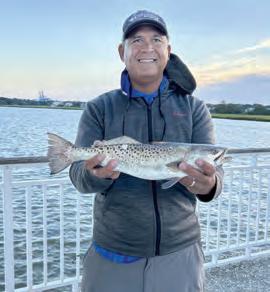
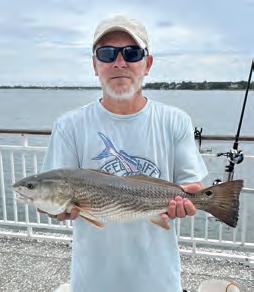
biggest sheepshead catches of the year. Fiddler crabs, fresh mussels, or sand fleas are popular baits on small Gamakatsu size 2 or 4 hooks using a light Carolina Rig. The River Watch Café & Gift Shop carries frozen sand fleas year-round as well as the hooks you’ll need if you are feeling like giving it a go.
For any additional information about the pier or what’s biting this week feel free to call the River Watch Cafe & Gift Shop on the pier at 843-762-9946
Chris Pounder, CPRP Manager, Mount Pleasant Pier


by Coastal Angler Magazine Lowcountry
When Chase Hunter took a job at Haddrell’s Point Tackle and Supply at just 14 years old, he wasn’t following the typical teenage path. While most of his buddies were entering the Charleston food and beverage industry, Chase had a different plan—one that brought him closer to the water and the world he loved.
Now, ten years later, he’s still behind the counter and proud to be the longest-serving team member on the floor. A trusted face in Charleston’s fishing scene, Chase has become a go-to for beginners and seasoned anglers alike.
“I’ve always liked talking about hunting and fishing and that’s most of what we do here,” he says with a grin. “It just made sense.”
Raised on the Water
A Mount Pleasant native, Chase grew up exploring the Lowcountry’s creeks and rivers. He went to Wando High School, gave Clemson a try, and ultimately chose trade school, still not finding the balance he was looking for, he knew that he wanted to be back where the action was: on the water and in the shop.

“I’ve fished most of the local spots from all over the Wando River to the waters of Edisto Beach but these days, I’m mostly offshore.”
Offshore, he’s usually bottom fishing 30 to 50 miles out, working depths between 100 and 200 feet.
“You’ll find vermilion snapper, black sea bass, gag and scamp grouper, sometimes even mutton or yellowtail snapper,” he says. “That’s my zone.”
A Changing Scene
Over a decade in the shop, Chase has watched the fishing landscape evolve— and not just in gear or boats.
“There’s just way more people on the water,” he explains. “Not all of them are fishing, but there’s definitely more pressure coming from more people fishing, especially on certain species.”
Redfish, in particular, have taken a hit.
“Back in high school, we could land 25 or 30 bulls in a trip. Now, if you catch five, that’s a great day.”
Chase attributes some of that pressure to technology apps, mapping tools, and the viral speed of social media sharing spots and techniques. Chase is concerned but not denying the future popularity of coastal fishing, just focused on education and conservation.
Bull Redfish Conservation Tips from Haddrell’s
The team at Haddrell’s Point, believes that sustainable fishing is just good fishing. Chase and the crew make a point to help customers fish smarter and protect the resource:
• Use circle hooks – less risk of deep-hooking big reds
• Deploy descending devices – especially when fishing deeper water
• Shorter leaders – reduce fight time and stress
• Proper venting – if needed, to avoid barotrauma
• Keep them wet – minimize air exposure, fast releases
• Respect the breeders – avoid targeting spawners during peak periods
• Pass it on – educate newcomers about catch-and-release ethics
“We always push to do right by the fish,” Chase says. “Especially those big breeders. That’s the future of fishing right there.
Dream Trip? Louisiana Rigs & Tuna on Topwater
Ask Chase about a bucket-list trip, and his eyes light up.
“Throwing poppers at yellowfin tuna in Louisiana… or jigging for exotic grouper species around the rigs—firebacks, marbled, misty. That would be unreal,” he says.
One of the Good Ones
If you’ve ever walked into Haddrell’s Point Tackle and Supply, there’s a good chance you’ve run into Chase—maybe asked him about baits, rigs, or tides. And if you did, you probably left a little more dialed-in than when you walked in.
“I think we’ve covered the bases,” he laughs as we wrap up.
No doubt, Chase. Whether it’s behind the counter or 40 miles offshore, you’re right where you belong.


November
November














by Jacob Cynar, Contributing Writer
hen I think of November, I begin thinking of holiday food and cooler weather. Lucky for me, the fish enjoy the same things! November is still a productive month for fishing at the Folly Beach Fishing Pier. With water temps in the mid-60s, the fish are still plenty active and looking to pack on the pounds for the winter. Look to come out after storms, as they can help clear up the water and help you spot fish.
Red Drum are still the locals’ favorite fish to target, and in November you can often find them schooling near the pier pilings and rocks. People are having success with throwing live bait and cut mullet. The larger reds can put up a fight, so make sure to bring the appropriate gear to land these Lowcountry legends. Sheepshead are also a pier favorite and begin bulking up when the weather gets cooler. Fiddlers and other hard-shelled baits are preferred, but make sure you pack your patience, as sheepshead are notorious for stealing bait.
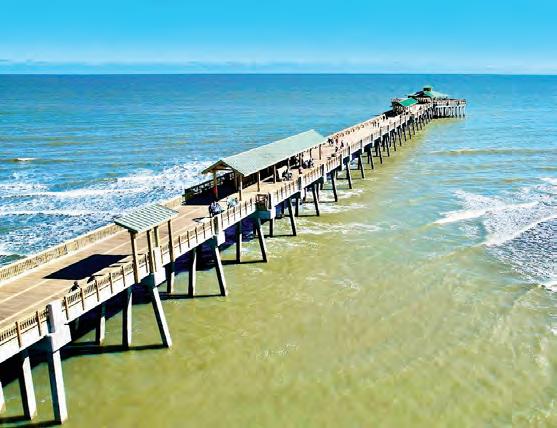
Incoming tides are particularly productive, especially if they come in early morning. When planning a trip out to the Folly Beach Fishing Pier, avoid peak high tide or dead low tide, as these are the least productive periods. I recommend a medium to heavy rod with a 2500–5000 size reel to catch just about anything at the pier. Switch up your tackle if you are looking to target anything specific. Also, look at switching up your fishing spot. The sandy sea floor under the pier changes daily, so your favorite spot might have changed with it! This fall we found that a 3-foot gulley formed under the pier. At high tide, this becomes a prime spot to target black drum and other fish that use this spot to target bait. This gulley is found just before the first sun shelter on the pier. Just because the weather gets colder does not mean the fishing has stopped! Come out to enjoy the cooler weather and take part in all the Folly Beach Fishing Pier has to offer!
Jacob Cynar, Operations Manager II
Folly Beach Fishing Pier
101 E Arctic Ave, Folly Beach, SC, 29439
843-762-9516 • Jacob.Cynar@ccprc.com

by Sea Sea Nunez, Contributing Writer
ovember Fishing in Beaufort, SC is just as good as October. Vast majority of fish are very active and aggressively feeding in preparation of the cold winter months approaching. Redfish, trout, black drum, sheepshead and even flounder can be found in almost every corner of Beaufort. Not to mention blue crabs are everywhere!
Tailing reds: Redfish can be found tailing the high tides in search of food. During this process, redfish can either be seen sharking through the waters in search of bait fish or burying their heads into the mud flats in search of fiddlers and other crustaceans exposing their tails above the water’s surface. There’s usually a 30-45 minute window during the incoming tide each day. However, it’s best to be out there as the tide begins to rise. If there is no success with live bait, switching to artificial bait usually works. Something like a top water or a soft plastic is best.
Sight fishing: This is a fun way to catch redfish. A soft plastic paired with an 1/8oz – 1/4oz jig head would be an ideal bait to use in this scenario. Usually using a brighter color lure on overcast days and a darker color on brighter clear days is best. But using a jerk shad would be better in comparison to a paddle tail as the paddle tail creates a bigger splash and might spook the fish. Casting a few feet in front of the redfish and moving away from them while using a pop or a bump technique is a good tactic to attract the fish your way and gives the angler more time to react to a potential bite.
Both these methods require patience as well as stealth movements. Theres a high risk of spooking the fish so wading the water slowly or using a push pole rather than a trolling motor is ideal.
One of the most important pieces of advice I have for this form of fishing would be to make sure you have a good quality pair of sunglasses. Being able to locate the fish while you’re either sight fishing or tailing reds is the most important step. If you don’t have a good pair of sunglasses, you will be limited to what you can see.
Black Drum: November is an excellent time to target black drum. As cooler weather sparks them to move into bays and creek mouths to aggressively feed. Black drum can be found in areas of oyster beds, docks, fallen trees, bridge pilings and any structure. If fishing oyster beds, the best time to fish is when the tide has covered the oyster beds as they are feeding on oysters and barnacles. Using a Carolina rig with a frozen or live shrimp, fiddler crabs, clams, or blue crab is best.
Trout: November is prime time for speckled trout as colder water sparks trout into a feeding frenzy. Shallow water and oyster bars with current will usually hold schools of feeding trout. Trout can be found by edges, points, on or around oyster beds. Mud minnow under a popping cork or jigged on the bottom using a 1/8oz gotcha or 1/8 ZMAN trout eye is effective. Trout trick, paddle tails, swimming mullet and top water are best artificials for trout. Fishing the midrise tide will about 1 hour after high is a great time for these guys.
Sheepshead: November is phenomenal for sheepshead and really picks up during this month as the water temperature drops into the 70’s. These fish love crustaceans and hard baits such as fiddler crabs, oysters, barnacles, clams and even frozen or fresh shrimp work. Sheepshead, like black drum, hang around structure such as fallen trees, bridges pilings, rock walls, etc. Using a sweeper jig or smaller hook below a few split shots or a drop shot rig work well. Jigging your bait just above the bottom is key. However, be sure to pay close attention as these fish are pretty clever and quick to steal your bait.
Flounder: Flounder are still around but slowly making their way offshore in preparation for the winter months. Fishing for flounder during outgoing tide is ideal as they are very predictable and enjoy
sitting in fast going currents. Fishing the bottom with a mud minnow, cut mullet or artificial bait works wonders. You can even catch these guys under a popping cork.
Bait Shrimping: Tis the season for baiting for shrimp! So if you have a set of bait poles, a cast net, and some shrimp bait, be sure to get your shrimp baiting license and head out to fill coolers full of shrimp!
Blue Crabs: Fishing for blue crabs can be very fun and extremely rewarding to all anglers. Crab traps are the easiest way to catch these guys, however hand lining and two ring crab nets are also a fun way to get the kids out of the house and into some fun family activities. Crabbing at docks or piers is a perfect spot as blue crabs tend to hang out beneath docks and piers. Crabs are not picky eaters. Chicken legs, thighs, and necks are popular and cheap bait to use. However oily fish such as menhaden, bonita, mullet, and ladyfish are much better baits to use for crabbing.
Any and all your fishing or crabbing needs can be filled at Sea Sea’s Honey Hole Bait & Tackle Shop in Port Royal, SC. We love to help customers and can answer all your questions. Please let us know if there is anything we don’t have as we are always willing to order new tackle.
Keep an eye out for our Sheepshead Tournament in November. Date TBD.


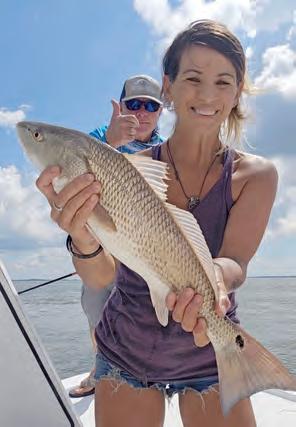

by Capt. Kevin Mears, Contributing Writer
t's November and fishing in the Lowcountry has started getting into a late fall and early winter pattern. The air and water temps are both cooling down and that means the fish are starting to get into schools. My favorite fish to target this time of the year are red drum and black drum. these fish will be found in the same types of places. These places are docks, rocks and trees. Just remember when fishing around docks please be respectful of the private property. Look for these types of structure around drop offs and bends in small creeks. These fish will eat fresh shrimp, frozen shrimp , and blue crab cut into pieces. You will also find the sheepshead in these same places with their preferred bait being small live shrimp and fiddler crabs. Trout can be found this time of year around points and drop offs with current. They are ambush feeders and like to attack the prey from below. They can be caught on rattle corks or popping corks rigged with live shrimp or mud minnows. Fish different depths until you find where the trout are hanging out. They can be a lot of fun to catch because the like to gather in large schools.
My favorite set-up when targeting the redfish and black drum is a 3000 series reel with a 7' or 7'6'' medium action rod with 30# Power Pro braid. I will rig this with a Carolina rig that has a 3/4 to 1 oz weight with 12'' to 14'' of 30# to 40# mono leader and a 2/0 hook. The only thing that I do different is when targeting the sheepshead I will use a 6'' leader. The shorter leader helps detect the subtle strike of the sheepshead. Another productive method is using sweeper type jig heads tipped with fiddler crabs.
Before heading to the out be sure to check out Beaufort Boat and Dock supply in Port Royal, they can get you set up with the bait and tackle you need for a successful day on the water. Tight Lines, stay safe and please be courteous to fellow anglers.














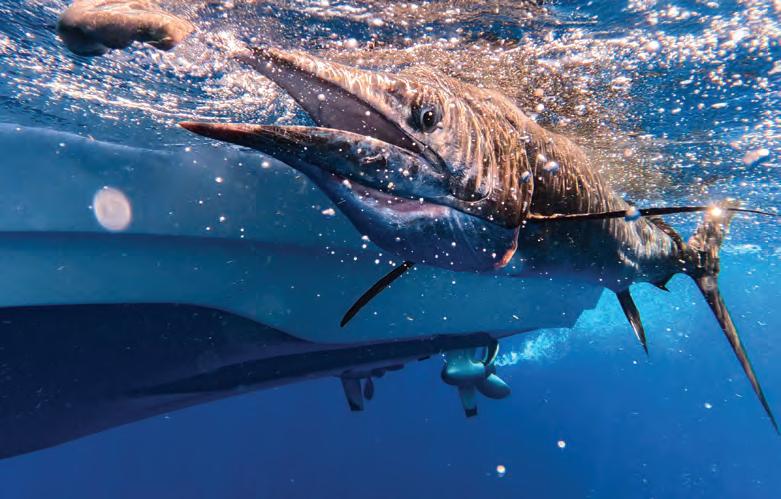
By Will Schmidt
Sail!sh are known as the fastest !sh on the planet, but they o er more than blazing speed to those who chase them o Florida’s east coast, such as I did on a recent !shing excursion. Spectacular surface bites and astonishing acrobatics make these !sh a coveted catch for even the most experienced anglers. For !rst timers, it’s an adrenaline !led !ght that will stick with you long a er the !sh swims back into the cobalt blue Atlantic. is trip was special for a few reasons. First, we had rising country star Ben Gallaher (IG: @Ben_Gallaher) with us. Ben is an avid outdoorsman and bass !sherman, but he had never caught a saltwater !sh. I was also excited to !sh with some new friends, Capt. Geoge Gozdz of “Unfathomed” (IG: @captgeorgegozdz) and Chris Bishop, VP of marketing at Yo-Zuri (iG: @Yozuri_Lures).
A er just a short run o Port St Lucie, we set our spread, and I could sense any strikes would likely be dramatic. e water was crystal clear and glass at giving us a great view of any action. e !rst !sh in, came crashing into the spread chasing and slashing at a bait with its bill. Unfortunately, as aggressively as it came in, it turned and retreated without eating.
As we reset the spread anticipation grew to !nd Ben’s !rst saltwater adversary. Fortunately, another sail came in a smashed the right rigger. However, it ran right at us, and we were never able to get tight. Undaunted, we set up again. Soon all the baits were nervously darting on the surface. e le atline erupted as the sail slashed, splashed and devoured the bait. Ben was on, and this !sh leapt and twirled with all the acrobatics of a Cirque du Soleil show. ere was still another to eat and moments later we doubled up. Both !sh cooperated with plenty of arial antics and a er a good !ght we had both !sh to the boat. To say Ben was pumped to land his !rst bill!sh is an understatement. Amped up with adrenaline and ready for more he could only beam with an ear-to-ear grin and say “let’s go!”

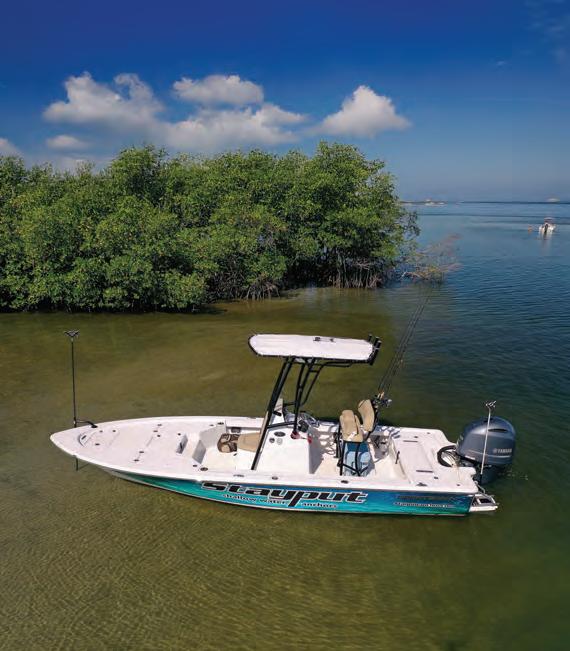








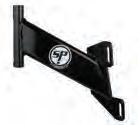

Fall !shing o of Port St Lucie o ers warm water and a hot bite without having to battle high winds and cold temperatures o en associated with winter sail!sh !shing in Florida.. Moreover, it’s not di&cult at all. We were simply bump trolling large, bridled thread!ns. Bridling helps the bait last longer and doesn’t allow for the hook to turn into the thread!n causing a missed strike. Our tackle was medium Penn Carnage rods with Authority reels lined with Yo-Zuri Super Braid topped with Yo-Zuri’s Disappearing Pink Fluorocarbon leader. ese setups gave us the sensitivity to feel the “eat” and the stealthiness to fool even the most cautious of !sh in these clear conditions. On your next trip don’t rush past these exciting sails, stop for some fun acrobatic action.
Will Schmidt is a seasoned tournament angler who has been writing about shing for more than two decades. Follow Will on Instagram @saltynstrong.



It’s no fsh tale when you run with a John Deere. You can get everything done faster and easier, so you get more time on the water. Plus, our special offers make them the catch of the day.



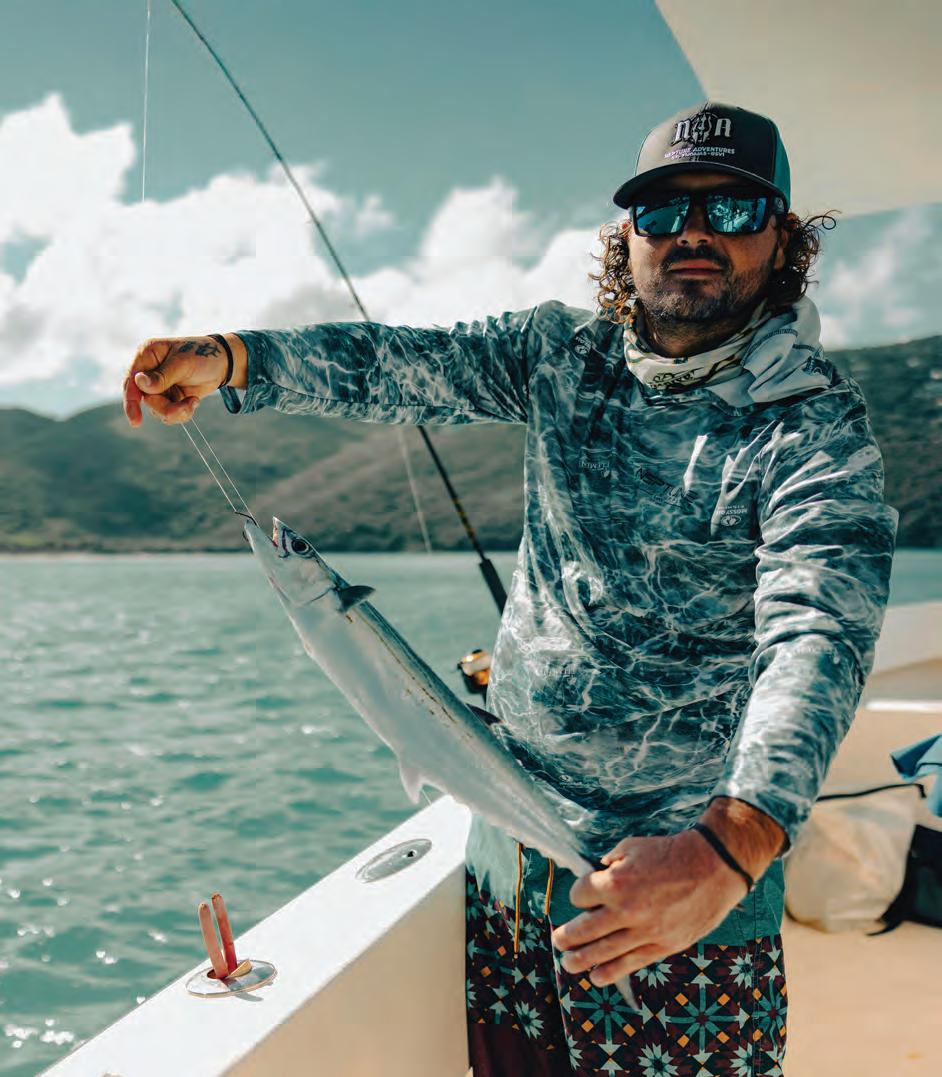
Anglers from around the world come to the U.S. Virgin Islands to !sh our incredible turquoise waters for trophy blue marlin, black!n tuna, wahoo and mahi-mahi. And with no passport required for U.S. citizens, it’s easy to plan your next !shing trip. Whether you want to set o on a crewed charter complete with a professional captain or prefer to simply cast a line from one of our scenic white-sand beaches, get ready to reel in the big one. Plus, many out!tters can customize your trip to include thrilling underwater activities like snorkeling.
O the island of St. Croix choose your own adventure, whether you’re looking to !sh o shore for mahi-mahi, wahoo, king!sh, tuna and blue marlin, or nearshore for tarpon, snapper, mackerel, rainbow runner and jacks. Seasoned crews who have been !shing the waters of USVI for decades will take you on customizable charters in search of catching your trophy !sh of a lifetime. Some out!tters o er complimentary !sh cleaning services, so all you have to do is throw your coveted catch on the grill or in the pan!
From St. John, troll for big game !sh—blue marlin, sail!sh, tuna, mahi-mahi and wahoo—on an o shore charter. Opt for a nearshore charter to catch bonito, barracuda, rainbow runner, snapper and
sharks. Or join an inshore bottom !shing trip to cruise the USVI’s deep-water reefs. Whether you’re an experienced angler or a novice needing some guidance, you’ll !nd an out!tter equipped with all the top-of-the-line !shing gear you’ll need for a successful day at sea.
About 20 miles north of St. omas is the North Drop, an area unparalleled for its big game !sh. Book a deep-sea !shing charter and sail over to this corner of the Caribbean that boasts more blue marlin bites per boat than any other place in the world. Half-day to 10-hour o shore bait !shing charters are ideal for adventurous anglers eager to experience the island’s famous North and South Drops. A mix of trolling and live baiting makes for mega catches, with yellow!n tuna, wahoo, mahi-mahi and blue marlin the most common catches of the day.

Surrounded by pristine blue waters, it’s no surprise that fresh seafood is a delicious part of nature’s bounty in USVI. You’ll !nd plenty of seafood-focused restaurants, from elegant !ne dining to laid-back waterfront eateries. Some out!tters even o er a stop at a seaside restaurant as part of their !shing excursions.







When the leaves start to turn and the water temps dip, bass anglers know what time it is—the fall feed. Bass are chasing bait like crazy, and it’s one of the best times of year to put big !sh in the boat. e trick is knowing what to throw as the season shi s. Here are !ve proven fall baits that will help you stay on the bite no matter what the lake throws at you.
Spinnerbait: Few baits scream “fall” like a spinnerbait. When the wind picks up and shad push shallow, it’s hard to beat a double willow blade ashing through the chop. e ash and thump imitate a school of eeing bait!sh, and hungry bass can’t resist. Target windy points, creek mouths, and shallow ats anywhere the bait’s getting pushed around.
Lipless Crankbait: is one’s all about covering water. Fall bass are constantly on the move, and a lipless crank lets you !nd ’em fast. Burn it over grass, rip it free when it hangs up, and hold on! at reaction bite is what fall !shing’s all about. Red or chrome patterns are money this time of year, especially when bass are chasing shad.
Jerkbait: Once the water clears and the temps drop into the 60s, it’s jerkbait season. Work it with a twitch-twitch-pause cadence, and you’ll mimic dying bait!sh to perfection. is lure shines around suspended bass that hang
o points or creek channels.


RJust be patient. Sometimes the bite comes right when you least expect it, on that long pause. Squarebill Crankbait & Swimbait: To round out your fall lineup, keep a squarebill and a swimbait on deck. A squarebill is your go-to for shallow cover stumps, rocks, laydowns, anywhere bass are ambushing bait in the backs of creeks. Meanwhile, a so or hard-bodied swimbait is ideal when you’re around big !sh feeding on larger forage. Slow-roll it through bait schools or along creek channels for some of the biggest bass of the year.
Fall is all about !nding the bait, and these !ve lures all mimic shad in their own way. Whether you’re slow-rolling a spinnerbait through wind-blown banks or ripping a lipless crank across a at, the !sh are feeding and it’s your job to get in on the action. Grab a few of these baits, follow the shad, and enjoy one of bass !shing’s most exciting seasons!
Tyler Woolcott is a professional tournament angler and guide. Check out his website at www.tylerwoolcott shing.com.

ed!sh are one of the most sought a er game !sh by inshore !shermen from Texas to the Carolinas. ey are great !ghters; they are great tasting; and they are perfect for sight !shing because they love super shallow water. Red!sh are part of the drum family and have four nostrils. is tells us that scent is their chosen sense while searching for food in dark and murky water.

e best red!sh lure that I have ever used is the 3-inch Berkeley Gulp! Shrimp. Berkeley Gulp! products are the smelliest baits that I have ever smelled and red!sh love them. ere are probably other stinky baits that work, but I haven’t found one that is comparable to Gulp! products. e best colors are anything with brown and gold glitter. Rootbeer and new penny are the best choices. e second best lure for catching red!sh is the gold or copper weedless spoon. ese are great search baits when you cannot see the red!sh. A slow retrieve with almost constant contact with the bottom is the way to !sh these lures. ese lures are exceptional for casting. ey cast a mile and let you cover a lot of water as you search for the schools of red!sh in the shallows.
e third best lure for red!sh are 3- and 4-inch paddletails rigged weedless. is is another great search bait for covering large areas of water. You will want to retrieve your paddletail in a similar way to your spoons. Make sure to bounce it o the bottom as you slowly retrieve it.
Contact Capt. Mike Smith, owner of Fish Your Ass O Charters, at (561) 339-2317, contact@ shyourasso .com or shyourasso .com.








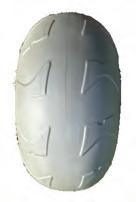
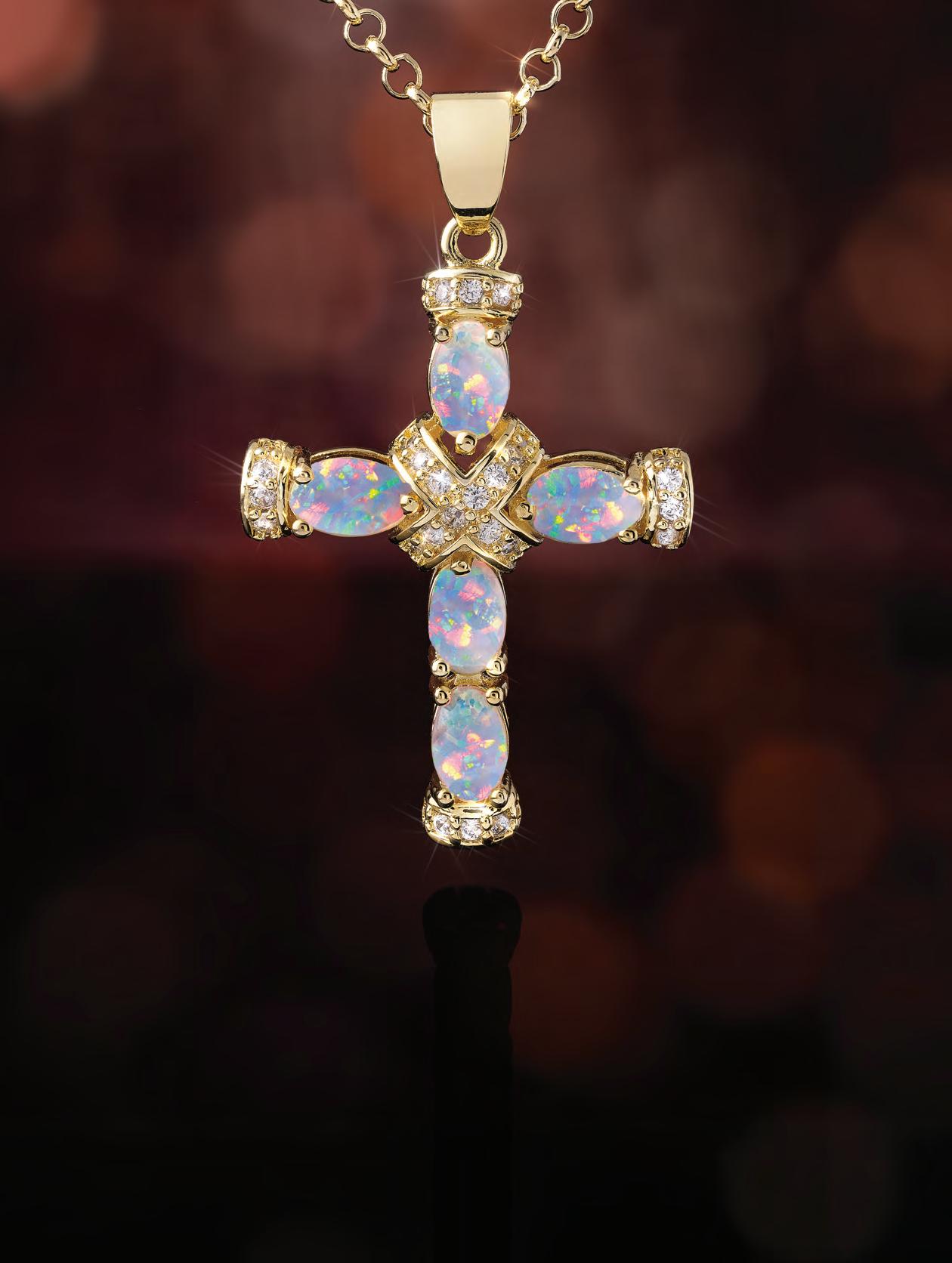
“I never expected it to be so beautiful that it takes your breath away.”
— Kaya C., on Stauer Opals
In a quaint village, nestled between rolling hills, lived a young woman with a deep appreciation for gemstones. Her grandmother gifted her a delicate cross pendant adorned with opals. "e opals shimmered with a mesmerizing play of colors, reflecting hues of blues, greens, and fiery oranges. Her grandmother shared the legend of the opals, believed to bring hope, purity, and luck to those who wore them.
Using this story as inspiration, Stauer brings you the Opal Spirit Cross Pendant. With over 2 total carats of Kyocera lab-created opals set in .925 sterling silver encased in yellow gold, this pendant is a radiant celebration of beauty and craftsmanship. Each opal captivates with a kaleidoscopic dance of fiery oranges blending into oceanic blues, streaked with flashes of vibrant green that seem to come alive with every movement. "e shimmering opals are skillfully arranged to create an enchanting, otherworldly glow, embodying the spirit of hope and harmony. "is breathtaking combination of color and craftsmanship is available as a limited availability of only 930 pieces, making it a rare and treasured addition

to your jewelry collection. Plus, when you order today, you’ll receive the Opal Spirit Cross Pendant at an impossible price of just $59 normally $149!
Don’t miss your chance to own this exclusive tribute to timeless elegance and meaningful symbolism.
Jewelry Speci!cations:
• Pendant: 2 ½ ctw. Kyocera lab opals and DiamondAura® accents. Yellow gold-finished .925 sterling silver setting
• Chain: 18" gold-clad .925 sterling silver chain
Opal Spirit Cross Collection

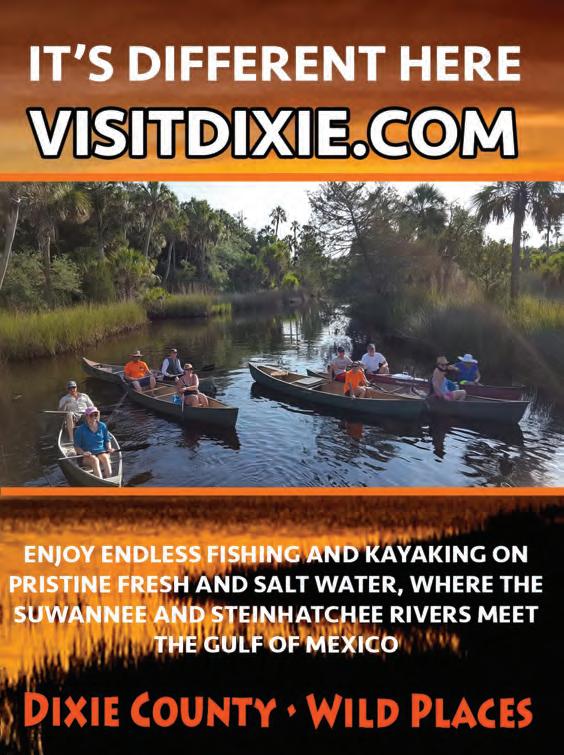
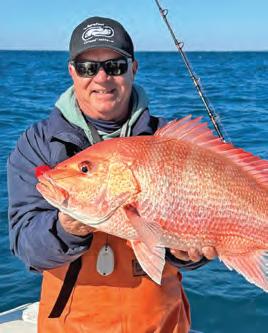

ovember is almost a completely unique month of the year. We’ll start getting the !rst real cold fronts, and this will pile the bait on temp breaks. Structure on the bottom will certainly hold the grouper and snapper on the bottom, but pay attention to the recorder and the marks in the mid water column. ese marks can be a number of the targets we’re looking for. Black!n are a given during the month of November, but it’s “go time” for wahoo and yellow!n. e bait can stand colder water than the pelagics. is is one of their biggest defensive strategies, and why you should have a (realistic) jig ready that can !sh 75-150 feet deep around the bait balls because the surface water will likely be as much as a few degrees warmer that the surface water due to the cold wind blowing overhead. Keep live baits out on circle hooks and ourocarbon and try to get some lower in the water column. ese live baits are black!n bombs ready to go o , but I am always drawn to the bottom in search for the grouper and snapper. Some of these same live baits or frozen cigs and sardines on the correct jigs (hint, hint) are irresistible to the !sh I’m really looking for. I want the big grouper and snapper bite. When you !sh the correct baits using the correct presentation, you’re not asking them to eat it, you’re MAKING them eat it! BAM! is is also African pompano candy. e jig in the mid to lower part of the water column is deadly, but if there’s no bites !shing it deeper and deeper all the way to the bottom, bring it up to the surface and repeat the process.

A trolling motor will really help in this controlled dri , keeping the bow forward into the wind and/or current. is will keep the light line out back and the baits on or near the bottom slightly back depending on the current. is is the bottom line: bag the trolling crap, post up on stacks of bait with dedicated crew for the light line and/or jig and dedicated crew on the bottom to generate groceries in the cooler. is is my kind grocery shopping.
Learn the drill of how to !sh the entire water column nice and quiet with beautiful baits and tactics for results. Dress with proper !tting foul weather gear and take plenty of photos and videos you can enjoy for years to come.
Learn more from Tim Barefoot on his YouTube channel and at barefootcatsandtackle.com.
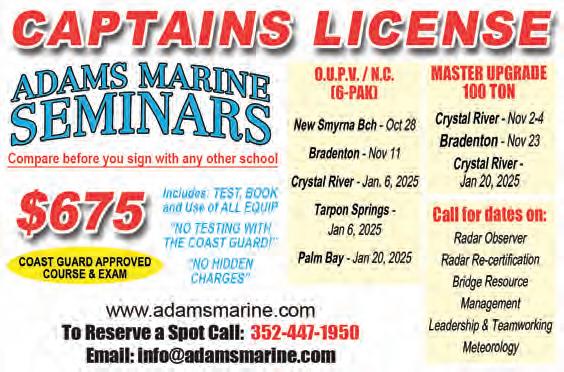
Spot Call: 352-447-1950



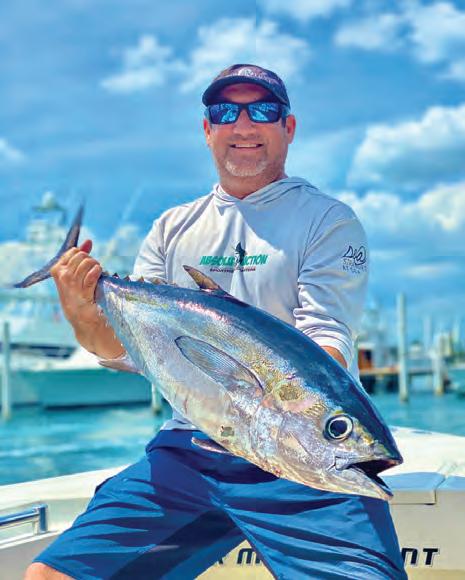





It was a warm summer afternoon and my wife and I were mingling with the best of them. The occasion was a 1920s-themed party, and everyone was dressed to the nines. Parked on the manse’s circular driveway was a beautiful classic convertible. It was here that I got the idea for our new 1920s Retrograde Watch.
Never ones to miss an opportunity, we carefully steadied our glasses of bubbly and climbed into the car’s long front seat. Among the many opulent features on display was a series of dashboard dials that accentuated the car’s lavish aura. One of those dials inspired our 1920s Retrograde Watch, a genuinely unique timepiece that marries timeless style with modern technology.

With its remarkable retrograde hour and minute indicators, sunburst guilloche face and precision movement, this design is truly one of a kind. What does retrograde mean? Instead of displaying the hands rotating on an axis like most watches, the hands sweep in a semicircle, then return to their starting point and begin all over again.

Retrograde watches by the big brands can set you back thousands; one recent offering from a big French fashion house is selling for more than $150,000! But because we’ve designed the 1920s Retrograde Watch in-house, we can offer it to you for just $99!
This watch is so wildly popular with our customers that we’re actually concerned about running out; we only have 937 729 left for this ad!
Join more than 1 MILLION smart people who love stauer watches

Watch Specifications:
• Precision movement
• Stainless steel case, caseback and crown
• Retrograde hour and minute indicators
• Water-resistant to 5 ATM




• Brown genuine leather band
• Fits wrists up to 8"
1920s Retrograde Watch
$399 $99* + S&P Save $300

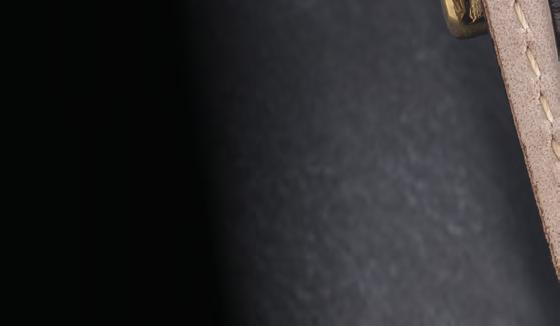
*Special price only for customers using the offer code.





“An elegant and exciting timepiece that every collector will love.”
— George Tomas, internationally renowned watch expert



“[A] unique and beautiful timepiece.”
— Carlos C., Los Banos, CA

